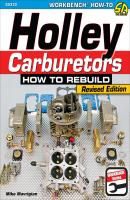Holley Carburetors. Mike Mavrigian
Чтение книги онлайн.

Читать онлайн книгу Holley Carburetors - Mike Mavrigian страница 6
Название: Holley Carburetors
Автор: Mike Mavrigian
Издательство: Ingram
Жанр: Сделай Сам
isbn: 9781613253144
isbn:
The 4160-series carbs are easily converted to 4150 status: Remove the metering plate and its gasket and then install a metering block with the appropriate gasket and longer fuel-bowl screws.
The front and rear fuel bowls, front metering block, and rear metering plate on this 4160 carb have been removed. Note the external fuel transfer tube on this carb (PN 1850).
A metering plate provides a “fixed” secondary enrichment. A metering block allows fine-tuning with replaceable jets.
4150 Details
This is an example of a 4150 carb (PN 4779). It has 750 cfm, double-pumper operation with jet-equipped primary and secondary metering blocks and mechanical choke.
Holley Double Pumper carbs are available in various finishes, including this traditional chromate.
All 4150 carburetors have metering blocks at both the primary and the secondary sides.
All Double Pumper carbs include a dedicated accelerator pump for the rear secondary side.
Double Pumper carbs have fuel bowl level-checking ports. This carb (PN 4779) has the traditional brass-thread plugs that are removed to check fuel bowl level while adjusting float level.
Center-hung fuel bowl floats have needle and seat float adjustment. To make an adjustment, loosen the slotted plug (which is the lock), turn the hex to make the adjustment, and then tighten the lock.
This street Ultra HP has red billet anodized metering plates and baseplate.
Notice the “V” shape on this fuel bowl casting, which clearly indicates the use of a center-hung float.
Here, the primary fuel bowl has been removed on a 4150 to reveal the primary metering block.
Center-hung floats pivot at the upper center of the fuel bowl and are less susceptible to fuel-bowl level changes during hard-driving maneuvers.
The jets on the metering block thread in at the front side; the power-valve threads in from the rear of the block. The power valve is rated at a specific vacuum, in inches of mercury. They are usually found only on the primary side but are also installed on the secondary metering block of certain high-performance models.
This is part of the fuel enrichment circuit that opens gradually to full open, depending on engine vacuum. During cruising, the valve is shut. As engine-load demand increases upon acceleration, engine vacuum begins to drop, allowing the power valve to open. Power valves are available in a range of vacuum ratings, which allows you to tailor it according to your needs.
A Holley power valve includes a four-sided head that can be serviced with a 1-inch wrench, but the flats are fairly thin. A dedicated power-valve wrench is highly recommended.
This white plastic piece is commonly referred to as a “whistle.” It aids in preventing fuel from spilling out of the primary vent tube during hard accelerations. They are featured on some carbs but are added easily to those without them.
The primary and secondary fuel bowls and metering blocks have been removed on this typical 4150-series carb. This is a 750-cfm Double Pumper (PN 4779).
Parts that are interchangeable between the 4150 and 4160 series include jets, power valves, floats, needle/seat assemblies, vacuum diaphragm springs (for those equipped with vacuum secondaries), fuel bowl vent components, some accelerator pump hardware, primary bowl gaskets, and, of course, carb-to-manifold gaskets.
Double Pumper
If a 4150 carb has mechanical secondary operation, it has both a primary and secondary accelerator pump, and is referred to as a Double Pumper carb. Depending on the model, 4-barrel carburetors have either vacuum-operated secondaries or mechanical secondaries.
All primary sides include an accelerator pump, which is activated by the throttle linkage. The pump serves to inject an added boost of fuel to eliminate bog or lag when the throttles are opened, which is especially critical at lower engine speeds.
With a vacuum secondary design, the secondaries begin to open according to vacuum developed in one of the primary bore venturis, as engine load increases. During quick accelerator operation under load, a slight delay may be encountered while the secondaries begin to open. You can tune the vacuum secondary by changing to a lighter or heavier spring inside the vacuum diaphragm housing.
Double Pumper carburetors are equipped with mechanical secondaries; a second, separate accelerator pump circuit is located on the secondary side. The secondaries receive an immediate shot of initial fuel from the secondary’s accelerator pump as the throttle linkage progresses.